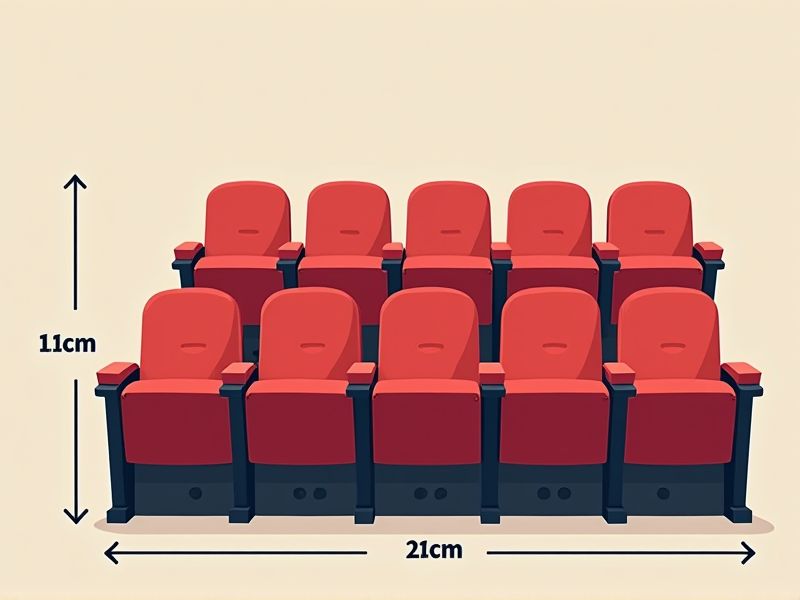
When designing theatre seating, standard dimensions help ensure comfort and clear sightlines for the audience. Generally, each seat is about 20 to 22 inches wide, with a row-to-row spacing (called "seat pitch") of 34 to 36 inches to provide adequate legroom. The aisles should be at least 42 inches wide to allow easy access and comply with safety regulations. Keeping these dimensions in mind can create a comfortable and accessible environment for all theatre-goers.
Row Spacing
Row spacing in theatre seating is crucial for ensuring comfort and accessibility, typically ranging from 32 to 36 inches between rows. This spacing allows for easy movement and minimizes the risk of discomfort for patrons, particularly in terms of legroom. Many theatres adopt varying spacing depending on the overall capacity, with larger venues often providing more generous distances to accommodate diverse audience sizes. Proper row spacing not only enhances your viewing experience but also adheres to safety regulations, allowing for efficient evacuation in emergencies.
Seat Width
The standard seat width in theatre seating typically ranges from 18 to 22 inches, allowing for comfortable accommodation of various body sizes. This measurement is crucial for ensuring that patrons can enjoy their experience without feeling cramped or restricted. In addition to seat width, the overall configuration of rows and aisles must adhere to specific regulations to enhance accessibility and safety. Investing in wider seats can significantly enhance your audience's comfort, potentially leading to increased attendance and enjoyment during performances.
Aisle Width
The standard aisle width in theatre seating is crucial for ensuring audience safety and comfort, typically ranging from 36 to 48 inches. This measurement allows for easy access and movement during performances, accommodating various needs, including those of individuals with disabilities. Adequate aisle width also facilitates quicker evacuations in emergencies, enhancing overall safety for all patrons. When selecting a theatre configuration, prioritizing this dimension can significantly improve the overall experience and compliance with safety regulations.
Legroom
In modern theatre seating, the emphasis on legroom is essential for enhancing audience comfort during performances. Standard legroom measurements often range from 34 to 38 inches, allowing for greater ease of movement and relaxation. Some theatres even incorporate adjustable seating options, enabling you to tailor the experience to your height preferences. Prioritizing this aspect not only improves patron satisfaction but can also lead to increased ticket sales and repeat visitors.
Sightlines
The standard of theatre seating significantly emphasizes sightlines, ensuring an unobstructed view of the stage from every seat. Optimal seat placement typically involves a slope or rake in the audience area with an angle ranging from 5 to 15 degrees, which enhances visibility for patrons. Seats are often positioned at least 12 feet away from the stage to maintain a clear line of sight while minimizing head obstruction from audience members seated in front. For a typical 1,000-seat theatre, the arrangement often incorporates a careful balance of distance, elevation, and spacing to maximize the overall viewing experience.
Balcony Overhang
Balcony overhang in theatre seating significantly enhances audience experience by optimizing sightlines and acoustics. A typical overhang extends 6 to 8 feet from the balcony edge, which can create an ideal viewing angle for those seated in the orchestra section below. This design not only helps to prevent obstructed views but also aids in sound projection, ensuring auditory clarity across the entire space. When considering your seating choice, understanding the impact of balcony overhang can elevate your overall enjoyment of live performances.
Seat Height
The standard seat height for theatre seating generally ranges between 17 to 18 inches from the floor to the top of the seat, providing optimal comfort for most adults. This height facilitates easy access for patrons, promoting a seamless transition to and from the seat while also enhancing overall viewing comfort. Ensuring that the seat backs are around 32 to 36 inches tall can further improve posture and support during performances. By maintaining these specifications, theatres can create a more enjoyable and engaging experience for all attendees.
Backrest Angle
The standard backrest angle for theatre seating typically ranges from 100 to 115 degrees, optimizing both comfort and line of sight for audiences. Research indicates that an angle of around 110 degrees provides the best ergonomic support, reducing fatigue during extended performances. Properly designed backrests can enhance the overall experience, allowing you to enjoy the show without discomfort. Many theatres also incorporate curve and contour designs to further improve lumbar support, ensuring a satisfying viewing experience.
Rake Angle
The rake angle in theatre seating is crucial for ensuring optimal audience sightlines and comfort, typically ranging from 5 to 15 degrees. A steeper rake improves visibility, allowing patrons in the rear rows to see over those in front, mitigating obstruction issues. For a venue with a seating capacity of 500, an ideal rake angle enhances overall viewer experience, significantly increasing satisfaction ratings. When designing your theatre, consider incorporating adjustable rake options to cater to various performance types and audience needs.
Accessibility Features
The standard of theatre seating prioritizes accessibility by incorporating features such as wheelchair spaces, companion seating, and wide aisles, which collectively enhance patron comfort. Approximately 10% of seating in modern venues is specifically designated for individuals with mobility impairments. Accessible seating areas are often strategically located to provide optimal sightlines and ease of access, ensuring that everyone can fully enjoy performances. By adhering to the Americans with Disabilities Act (ADA) guidelines, theatres aim to create an inclusive environment, allowing you to experience the arts without barriers.
